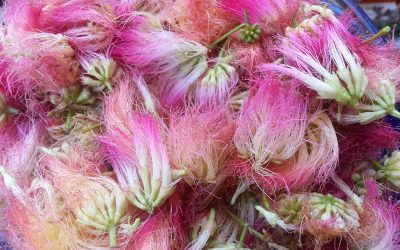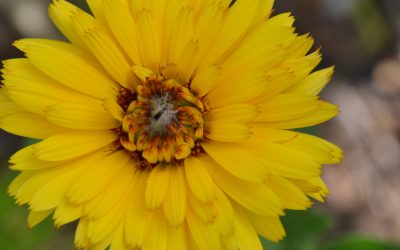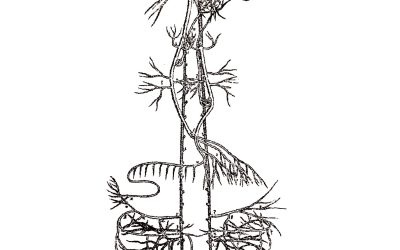Artemisia/Sage: The Ecology of Herbal Medicine
The following is an excerpt from Dara Saville’s new book The Ecology of Herbal Medicine: A Guide to Plants and Living Landscapes of the American Southwest from the University of New Mexico Press (2021).
Artemisia species (sage) have been culture-influencing plants across continents, shaping the lives of people in both the Old World and the New. A widespread genus with a large number of species, Artemisia has been associated with mythological lore, supernatural activity, spiritual beliefs and practices, absinthe-inspired counterculture, and healing practices across time and space. There are many Artemisia species in the American West, including nonnatives such as A. absinthum, but also as many as forty-three native species, some having limited ranges while others (for example, A. ludoviciana, A. dracunculus, A. frigida, A. tridentata, and in the Southwest A. filifolia) are widely distributed. Although there is considerable overlap, with most species having similar uses, commentary here focuses on these more common varieties. Many of these species are found in a wide range of habitat types, including desert shrub, forest, woodland, prairie, grassland, and even alpine
environments, and serve as important forage for pronghorn and other ungulates, small mammals, birds, and insects. Some sages are also useful for revegetation projects, as they have varying qualities of resprouting after fires, a willingness to colonize disturbed areas, rapid growth and spreading habits, and soil stabilization capabilities. Artemisia tridentata, in particular, is one of the most widespread shrubs in the American West and includes several subspecies that are important habitat and nutritive forage for sage grouse and numerous other animals. It is also valuable for range restoration. It is associated with mycorrhiza from the genus Glomus and may be dependent on that relationship, making it difficult to reestablish after severe burns or mycorrhiza-damaging infestations of cheatgrass (Bromus tectorum).

The lore of sage takes us back to ancient Greece, when the goddess Artemis gave this plant to the famed herbalist centaur Chiron for use in his medical teaching and practice. Sage, also known as wormwood, shapes biblical stories as a plant that rose up from ground in Eden that was touched by
the serpent and became associated with disaster and sadness (Richardson 2017). Another Christian story tells of a star named Wormwood that fell from the sky into waters and springs, contaminating
them with bitterness that sickened and killed those who drank it (Richardson 2017). Wormwood also became a literary symbol for the bitterness of words in Shakespeare’s Hamlet. But this herb also has positive associations, including a use in love potions and divinations, increasing psychic powers, protecting against evil spirits and disease, and bringing good luck (Richardson 2017). It has also been used as an antidote to deadly poisons, including hemlock, mushrooms, and sea dragon bites; as a vitality-promoting nervine and digestive tonic; and in various libations such as beer, wine, absinthe, and vermouth (Grieve 1971 [1931]).

An herb of potent medicinal actions, sage has a long history of use. Described by Pliny and Dioscorides in the first century CE, this herb was famed for its digestive actions, but is widely useful for a variety of conditions. Leaves and flowering tops are harvested and prepared as an alcohol extraction in the form of tincture or liniment, or as a dried powder, infused oil, poultice, steam treatment, or tea for both internal and topical applications. Nicolas Culpeper (2018 [1653]) wrote that sage clears excesses of the choleric temperament and prescribed it as a whole-body tonic. Herbalist Matthew Wood (2008) indicated sage for those with sluggish vital forces and people who are overwhelmed by the stressors of life. As a bitter digestive tonic, sage stimulates secretions and peristaltic action; increases liver and gall bladder functions; reduces heartburn, gas, cramping, and other symptoms of indigestion; and revitalizes those suffering from low appetite or otherwise poor digestion. Sage also helps clear the body of stagnancy and toxins through diuretic action that also moves urinary gravel and reduces edema. These stimulating and detoxifying actions in the digestive and urinary systems may be the driving force behind sage’s anti-inflammatory and pain-relieving effects, making it a useful treatment for musculoskeletal pain, arthritis, gout, and physical trauma resulting in bruising, sprains, broken bones, or damaged connective tissue. Sage is also a well-known vermifuge, antiparasitic, and antifungal capable of ridding the body of worms (especially pinworms and roundworms), repelling moths and other insects, and clearing athlete’s foot, scabies, and lice. Furthermore, sage’s antiseptic and anti-inflammatory properties are useful for treating wounds, bites, and stings, making oral health care mouthwashes, creating antimalarial medicines (A. annua), and treating jaundice. The herbal legacy of sage is most certainly shaped by its use in making absinthe, a potent liquor that is considered to be a nervine, mental restorative, and vermifuge. For many years, absinthe remained within the confines of herbal medicine but eventually crept into social culture and became an intoxicating beverage of poets, writers, artists, and the elite. The subject of much controversy, absinthe has been banned in many countries and heavily regulated in others but has remained a beverage of legend and intrigue throughout much of Europe and beyond.


Modern herbal traditions in the Southwest have maintained many of these uses with a focus on movement of stagnancy, especially in the respiratory and digestive systems. In high desert regions of the West, with cold dry winters, herbs that support the lungs are of great importance. Aromatic constituents including camphor make sage an effective clearing and decongesting remedy for colds, flu, coughs, asthma, bronchitis, sinus infections, and other respiratory ailments and diseases. Diaphoretic action also helps release the heat of accompanying fevers. Sage is known to stimulate uterine circulation, bringing healthy blood flow to the pelvic region in cases of scant or clotty menstrual flow and cramping. As a digestive remedy, Moore (2003) distinguished the Artemisia species that lack thujone, including A. filifolia, as these have differing effects. Whereas most species are considered stimulating digestive tonics that increase secretions in a cold and sluggish system, the thujone-lacking species are used instead to calm excessive secretions caused by gastric heat and inflammation. Thujone is also the reason for reported safety concerns with Artemisia species. The essential oil may expose people to high doses of this compound and should be used with caution. Dried herbal preparations, however, have much lower amounts of this chemical and when used appropriately should not be a cause for concern (Hoffman 2003). Although sage is quite potent as an internal remedy, topical uses make this herb more accessible for many. I make an alcohol-based spritz for environmental purification or for household cleaning. This same preparation with some glycerin added can be used topically for self-purification and bodily pain relief. Building on all these medicinal actions, sage has transformative powers that can be experienced only through knowing this plant in wild places. The species I know from the high desert grow in expansive dramatic landscapes, where vulnerability and exposure are woven into the relationship we make with this plant. As one passes through sagebrush flats, the aromatic particles on the wind perform their sensuous dance, moving the energy of the land around us and through us, transforming our state of being by shifting our awareness into the present moment through sensory immersion. In the American West, the magic of Artemisia is always at hand.

Scientific research adds more depth to our understanding of Artemisia in healing practices and highlights its potential role in the prevention and treatment of infectious diseases. Studies have identified numerous constituents, including alkaloids, amino acids, flavonoids, phenols, quinines, tannins, and terpenoids, contributing to its antimicrobial activity against numerous gram-positive and gram-negative bacterial strains and diverse fungal strains (Ahameethunisa and Hopper 2010; Bilia et al. 2014) as well as potential use in mycobacterial tuberculosis treatments (Gemechu et al. 2013). Abad et al. (2012) provided a detailed summary of a variety of Artemisia species, their active constituents, and antipathogenic activity but did not include specimens from the United States. Artemisia has also shown insecticidal (Liu et al. 2010) and anthelmintic activity (Akkari et al. 2014), including against ticks (Godara et al. 2014). This plant is perhaps best known in the medical world for its artemisinin, a highly prized chemical that is extracted from A. annua and used to make drugs that have become increasingly important in treating drug-resistant forms of malaria (O’Neill 2004). One artemisinin study observed rapid resolution of clinical malarial symptoms and cure rates of 74 percent, compared to 91 percent for drug therapy with quinine but with higher rates of recurrence (Mueller et al. 2004). Artemisia also exhibits antiproliferative actions against human breast carcinomas in both estrogenic responsive and unresponsive cell lines (Shafi et al. 2012) and cytotoxic activity against human colon cancer cells (Khalilli et al. 2017). Additional studies show that Artemisia is highly antioxidant (Ahameethunisa and Hopper 2012; Djeridane et al. 2007) and antidiabetic, and it lowers cholesterol by significantly reducing blood glucose, triglycerides, and other biochemical markers (Ghazanfar et al. 2014).
References are available in the book.





